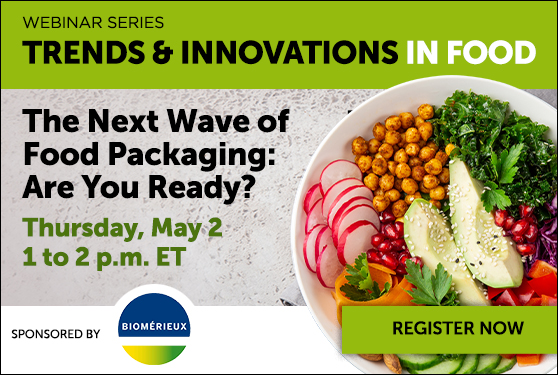
The federal government has made elimination of plastic from food packaging a priority. While it’s important to reduce plastic food packaging and divert them from landfills, there are no easy solutions. However, the food industry has the responsibility of meeting consumer desires for environmentally friendly packaging and more sustainable food that are also safe and delicious. How does the industry balance these needs? Change is coming, and we must be ready for it.
Speakers
Food in Canada’s editor, Nithya Caleb, moderated a webinar on this topic earlier this year. Panelists were Martin Gooch, PhD, CEO, Value Chain Management International (VCMI); Sarah Acchione, Procurement Manager, Italpasta; and Leonardo Giglio, Optimist & CEO, Tempo Flexible Packaging.
Martin Gooch, PhD, CEO, Value Chain Management International

Dr. Martin Gooch is co-founder and CEO of Value Chain Management International (VCMI), a global consulting company that helps businesses, primarily in the agri-food and seafood industries, enhance their long-term profitability and environmental sustainability. Packaging related analysis and innovations completed by the VCMI team in North America and Europe include optimizing food packaging and merchandizing options from environmental, economic and consumer perspectives. Martin holds a PhD and master’s degree in agri-food management, a bachelor’s degree in international business, along with qualifications in farm management and agricultural production. In 2013, Martin received Bayer’s “Outstanding Canadian” award for his contribution to “Food Chain Partnerships.” In 2017, the Ontario Produce Marketing Association awarded Martin the Cory Clack-Streef “Produce Industry Person of the Year.” Martin is a member of the PAC Global Leadership Council.
Sarah Acchione, Procurement Manager, Italpasta

Sarah Acchione is the Procurement Manager at Italpasta, which was founded in 1989. A passion and love for food is the driving force behind the quality products it produces. Inspired by Italy but proudly 100 per cent Canadian owned and operated, Italpasta pasta is made with 100 per cent Canadian wheat. Sarah joined Italpasta’s sales department in 2007 and became a national account executive in 2012. In 2022, Sarah transitioned into the role of Procurement Manager. Sarah is also serving as a member on the Board of Directors for Food and Beverage Ontario from 2017-2020, returning in 2023.
Leonardo Giglio, Optimist & CEO, Tempo Flexible Packaging

Leonardo (Len) Giglio has been the Optimist & CEO of Tempo Flexible Packaging since January 2021, working alongside his sister, COO Lee-Anne Giglio. Having inherited his passion for innovation from his father, co-founder and president, Joseph Giglio, Len is a driving force behind Tempo’s continuous improvement mindset. He is dedicated to rethinking flexible packaging in a sustainable manner and driving positive impact not just within the organization, but also across the team, partners, and community. Since joining Team Tempo in 2007, Len has held various business development and marketing roles– gaining insight into the practical and technical aspects of packaging production and understanding the specific needs of retailers and brand owners. This wealth of knowledge has been instrumental in the development of Tempo’s award-winning, recycle-ready solution line – HarmonyPack. An outspoken advocate for eliminating plastic waste and better end-of-life options for flexible plastics, Len serves on the advisory board of the Canada Plastics Pact.
Webinar Summary
At the outset, Nithya explained the policy changes impacting food packaging. In 2022, a country-wide ban on single-use plastics came into effect. In summer 2023, the federal government issued a pre-planning pollution prevention notice with proposed goals to weed out plastic from food packaging. This spring, the federal government launched the federal plastics registry, which requires plastic resin manufacturers, producers of plastic products, and service providers to report each year on the quantity and types of plastic they put on the Canadian market and how that plastic moves through the economy. These policy changes have significantly impacted the sector.
Impact of recent policies
“I foresee that the proposed policies would lead to three overarching outcomes: increase prices to consumers, reduce food availability, and increase environmental impact,” explained Gooch.
Acchione shared that these policies would increase the cost of packaging, which would inevitably be passed onto consumers, not an ideal situation given the market conditions.
Giglio was more optimistic, especially about the plastics registry. He believes the data collected by the registry would help us make the right decisions about packaging and reducing plastic pollution.
The importance of plastic in packaging
Acchione explained why plastic is essential in food packaging.
“There are a few reasons as to why it is essential in food packaging. One is protection. It protects fragile and vulnerable products throughout the supply chain and shields them from contamination, such as moisture, humidity, gases, micro-organisms, insects and light. Another is prevention. It preserves our products for a good shelf life. It prevents waste. It avoids spillage. It allows products to be transported over greater distances because we can stack products. It makes our transportation and supply chains much more efficient. It can also be printed on, allowing important information to be displayed on the product, she shared.
Giglio added that plastic is very cost-effective.
A broken system
Gooch was candid about the systemic failures that’s exacerbating plastic pollution in Canada.
“Every system has three key components. The product, the process and the infrastructure. The current focus is on the product [plastic],” he explained. The processes and infrastructure as well as how these three factors align haven’t been widely discussed in Canada. Gooch is of the view that we can have a properly functioning system only by allowing industry to take the lead.
Recycling issues
Acchione highlighted the inconsistencies companies like Italpasta face when it comes to recycling of their packaging. Most of the flexible packaging in the Canadian food industry is either polyethylene or polypropylene. They are recyclable in theory and are being recycled at many cities across the globe. However, in Canada, where recycling is done at the municipal level, there are some facilities that cannot recycle these products. Acchione would love to see some changes on that front.
Giglio added that many municipalities don’t have the wherewithal to recycle bioplastics, which is touted as an alternative to fossil fuel-based plastics. Another issue with bioplastics is the cost, which is significantly higher than traditional plastic packaging.
Alternative materials
One of the major challenges with new materials is the need for R&D to ensure it meets the needs of the F&B processor. It would be cumbersome and challenging to tweak packaging lines and test new material if one doesn’t have a dedicated R&D team or line. The other obvious hurdle is the need to potentially install a whole new packaging line, which is an expensive proposition for SMEs.
Additionally, while you can have the most recyclable packaging solution possible, it’ll become unrecyclable when you apply certain adhesives or inks on it.
Solutions
The panelists agreed that utilizing energy from waste would be good option instead of sending plastic waste to landfills.
Another important step in implementing a robust circular economy around plastic would be to simplify the types of plastic we use as well as segregating the types of plastic that are used in food versus used elsewhere.
There was a universal call among all panelists to have greater alignment between governments to enable efficient, effective blue box systems across the country.
We need one system, one standard, they said, because most of the companies do business in more than one municipality, and it’s really hard to create a packaging format across multiple provinces with multiple standards. Standardization would definitely be hugely beneficial.
Giglio acknowledged, “Today there might not be the perfect solution that’s either economically affordable or just feasible for the current equipment you have in your facility, but like every three to six months there’s something new happening in these materials that we’re generating. It’s constantly evolving. We’re learning. So over the next few months, if something’s not working, let’s try again.”
Watch the full discussion here.
This webinar series on “Trends and Innovations in Food” was sponsored by BioMérieux. Click here to watch the first webinar on “The Ozempic Effect” and here to watch the second webinar in this series on “AI’s Role in F&B Processing.”
Watch Webinar NowPrint this page
